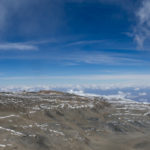 Map of Africa from 1813
Map of Africa from 1813
John Thomson [Public domain], via Wikimedia Commons, http://commons.wikimedia.org/wiki/File%3A1813_Thomson_Map_of_Africa_-_Geographicus_-_Africa-thomson-1813.jpg
Ancient knowledge of the world was spotty at best, and often based on many-times-removed hearsay. Historians and geographers weren’t able to simply hop on a plane, size up their subjects, and report on what they saw, so they often relied on muddled accounts, mythical tales that somehow made their way across the oceans, and when that failed them, their own imaginations.
Some mix of the above produced the first tales of the “Mountains of the Moon,” fabled snow-capped peaks in East Africa that were thought to be the source of the Nile river.
From ancient times all the way through to the late 19th century, finding the source of the Nile fascinated western explorers. Reports from a merchant in the Indian trade known as Diogenes— who claimed to have been blown off course during his usual sea voyage—brought Greek and Roman citizens news of the Mountains of the Moon, which Diogenes claimed were the source of the Nile river.
Diogenes allegedly discovered the mountains after landing near Rhapta, a city whose location has been lost (though it is known to have been somewhere along the East African shoreline; Dar es Salaam, Tanzania has been proposed as a possible candidate). Traveling inwards from the coast, Diogenes came upon mountains so high their tops were capped with snow; he reported that the natives called them the “Mountains of the Moon” (presumably because their white peaks recalled the moon’s white face), and that the Nile originated on their slopes.
Diogenes’s discovery spread in large part because of the writings of Ptolemy of Alexandria. Ptolemy wrote not only of the Mountains of the Moon, however; he also spoke of a “great snow mountain” nestled deep in the forests of East Africa, a reference that has long been considered one of the first allusions to Kilimanjaro (the only mountain in the region that’s permanently snow-capped).
Over the centuries, however, all knowledge of where these various landmarks—the Mountains of the Moon, Rhapta, and the great snow mountain—were located was lost (if it ever existed). Explorers obsessed with finding the Nile’s source often sought the mythical mountain range instead; after all, a mountain is an easier landmark to locate than a trickling stream.
No one has ever definitively located the mountains, but various geographers have claimed that the likeliest candidate is Kilimanjaro (others have mocked them mercilessly; apparently geographical disputes can get pretty vicious).
Even if the mountains could be pinpointed on a map, it wouldn’t answer explorers’ original question: where is the source of the Nile?
Today, the most common answer is usually Lake Victoria, located along Tanzania’s northern border. This seems to bolster claims that Kilimanjaro should be seen as the true “Mountain of the Moon”; it’s the largest nearby peak, and the only one capped with snow.
But mysteries are never solved that easily. Even today, the true source of the Nile is disputed; major feeder rivers into Lake Victoria are sometimes considered part of the Nile, meaning its true source could be one—or all—of their sources.
We’ll never know for sure what the ancients were referring to when they named the Mountains of the Moon, and claimed them as the world’s mightiest river’s source…
…but then it’s likely they weren’t 100% sure about that, either!






